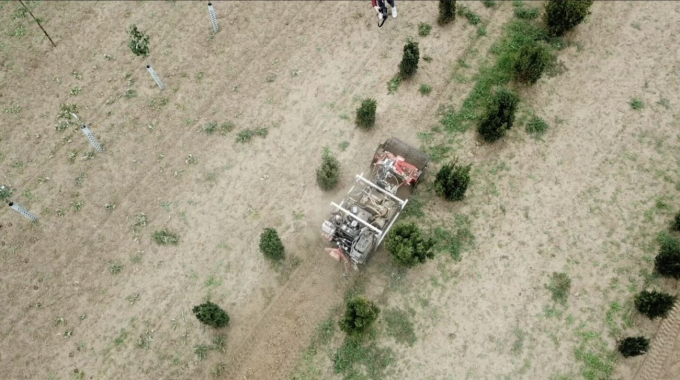November 10, 2025 | 10:32 GMT +7
November 10, 2025 | 10:32 GMT +7
Hotline: 0913.378.918
November 10, 2025 | 10:32 GMT +7
Hotline: 0913.378.918

Image courtesy of Federal Office of Agriculture and Food/Fraunhofer.
A German consortium is developing an autonomous robot, AMU-Bot, to solve the problem of manually hoeing weeds out of crops without having to spray those crops with herbicides or pesticides. The project is being funded by the German Federal Office of Agriculture and Food and coordinated by the Fraunhofer Institute for Manufacturing Engineering and Automation. The institute also designed the height-adjustable rotary harrow that the bot uses to pull up the weeds.
The bot moves along caterpillar-type treads and is capable of autonomously traveling up and down rows of plants in all types of farming settings — such as orchards, tree nurseries, or vegetable fields. Using onboard lidar scanners, it’s able to stay between the rows while seeing where each row ends so it can turn around and repeat the process down the next row.
The AMU-Bot isn’t able to identify the specific types of plants. However, it is able to understand the difference between crop plants and weeds. When it sees a weed, the bot removes it. It’s able to do this via a rotary harrow that churns up the soil and uproots the weed. It’s also able to pull the weeds growing between the rows by deploying the harrow directly in front of the robot as it moves forward. However, if the robot sees a weed growing inside the row of crop plants — between the crops themselves, it stops and moves the harrow sideways into the space.
For now, it’s not known whether or not the weed-killing robot will enter service. There are also other types of robots being developed that use lasers and electrical pulses to kill weeds.
Some Information On Herbicides — Particularly Glyphosate
Certain herbicides can be pretty harmful to the environment and life itself. Glyphosate is one in particular and it is the active ingredient in Roundup, which is the world’s most heavily used agrochemical. The website, Envirobites, which shares environmental research for everyone, looked at two studies by the US Environmental Protection Agency conducted in 2017.
These studies are no longer accessible on the web, but Envirobrites notes that the EPA evaluated the effect of this herbicide on plants and animals, including humans. Exposure can occur when you touch the chemical or ingest plants that have been sprayed. You can also be exposed if you breathe its vapors. The EPA looked at multiple toxic effects, especially lethality and reduced growth. The website noted that a dietary exposure study showed reduction in body weight and also eye, liver, and kidney toxicity at or above the limit dose, but that no toxicity effects were observed on the nervous and immune systems.
The EPA itself states that there are no risks of concern to human health from the current uses of glyphosate. In 2015, the International Agency for Research on Cancer (IARC), however, concluded that glyphosate is probably carcinogenic. Clearly, this is a widely debated topic and you can make of this what you will.
I often hear from friends abroad that a lot of our foods here in the US — mostly popular snack products — are banned in certain countries due to the chemicals that are put in our foods. These are usually from herbicides and pesticides or additives to enhance the flavor and appearance of food.
It’s also known that a lot of the junk food that is cheaper to buy leads to ill-health effects such as obesity, diabetes, and heart disease. With this in mind, I don’t think that herbicides are the worst of the bunch, but I do think having robots pull the weeds out instead of spraying stuff on the crops is a better way to go.
(Cleantechnica)

(VAN) Interview with Kaveh Zahedi, FAO’s Director for Climate Change, Biodiversity and Environment.

(VAN) China has begun purchasing U.S. farm products after leaders of both countries met last week, but traders await soybean purchases after the White House said Beijing pledged to buy 12 million tons by year-end.

(VAN) The State of Food and Agriculture 2025 report focuses on land degradation caused by human activities.

(VAN) Brazil on Monday opens three weeks of events linked to the COP30 climate summit, hoping to showcase a world still determined to tackle global warming.

(VAN) The US egg industry has undergone a fundamental decade-long transformation, transforming to a sophisticated, value-added sector primarily defined by the shift to cage-free production, according to a recent analysis by Rabobank.

(VAN) Rice fell to 21,200 won per kilogram in Pyongyang as fresh corn reaches markets and imported grains enter through border cities.

(VAN) Latest Global Forest Resources Assessment provides detailed analyses for 236 countries and areas.